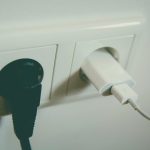Yes, daisy-chaining power strips can be just as dangerous as people say. It greatly increases the risk of electrical overload, leading to potential fire hazards and damage to your devices. Each power strip has a wattage limit, and combining multiple strips often exceeds that limit. It’s safer to use a single, high-quality power strip with adequate surge protection. To fully understand the risks and how to mitigate them, you’ll want to explore more on this topic.
Table of Contents
Key Takeaways
- Daisy-chaining power strips can significantly increase the risk of electrical overload and fire hazards due to excessive device connections.
- Each power strip has a specific wattage limit; exceeding this can lead to overheating and potential circuit damage.
- High-wattage devices amplify the danger when daisy-chained, stressing the importance of monitoring total load capacity.
- Many power strips may not comply with safety standards, making daisy-chaining potentially violate electrical codes and increase risks.
- Using a single, high-quality power strip with surge protection is safer than daisy-chaining multiple strips, ensuring better device safety.
Understanding Power Strips and Their Purpose
Power strips are vital tools for managing electrical connections in your home or office. They allow you to plug multiple devices into a single outlet, providing convenience and flexibility. You can connect everything from computers to chargers without needing to rearrange your entire setup.
Most power strips come equipped with built-in surge protection, which helps safeguard your devices against voltage spikes. This feature is essential for preserving the lifespan of your electronics.
Built-in surge protection in power strips is crucial for safeguarding your devices from voltage spikes, ensuring their longevity.
When choosing a power strip, check the wattage rating and the number of outlets to guarantee it meets your needs. Remember to avoid overloading your power strip, as this can lead to overheating and potential hazards.
Using power strips responsibly keeps your environment organized and your devices safe.
What Is Daisy-Chaining?
Daisy-chaining is a method where you connect multiple power strips together to expand the number of outlets available for your devices. By plugging one power strip into another, you create additional sockets for everything from chargers to appliances.
This technique can be tempting, especially when you need to accommodate several devices in a limited space. However, it’s important to take into account the total load your devices draw from the outlet. Each power strip has its own capacity, and exceeding that can lead to overheating.
While daisy-chaining might seem like a convenient solution, it’s essential to use it wisely. Always check the specifications of your power strips and verify you’re not overloading any single outlet in your home or office.
The Risks of Daisy-Chaining Power Strips
When you daisy-chain power strips, you’re putting your electrical circuits at risk of overload.
This can lead to increased fire hazards and even damage your valuable equipment.
It’s essential to understand these dangers before connecting multiple devices.
Overloading Electrical Circuits
While it may seem convenient to connect multiple power strips together, doing so can quickly lead to overloading electrical circuits. Each power strip has a maximum load capacity, and when you daisy-chain them, you risk exceeding that limit.
This can happen without you even realizing it, especially if you’re plugging in high-wattage devices like space heaters or gaming systems. Overloading can cause the wires to heat up, which increases the risk of electrical issues.
You might think you’re saving space or providing enough outlets, but you’re actually setting yourself up for potential problems. To keep your home safe, use individual power strips for each device and avoid connecting them together.
Your safety is worth the extra effort!
Increased Fire Hazards
Connecting multiple power strips not only risks overloading circuits but also greatly increases fire hazards. When you daisy-chain power strips, you create a potential recipe for disaster.
Each strip has a maximum load capacity, and exceeding that can lead to overheating. This heat can ignite flammable materials nearby or even spark a fire within the strip itself. You mightn’t notice the danger until it’s too late, especially if you’re using high-wattage devices like space heaters or irons.
It’s essential to prioritize safety by using power strips as intended. Instead of chaining them together, consider using a single, high-quality power strip with built-in surge protection.
Your home and safety are worth the extra effort to avoid this fire risk.
Equipment Damage Risk
Daisy-chaining power strips not only poses fire hazards but also risks significant damage to your electronic devices.
When you plug multiple strips together, you increase the chances of overloading the circuits, which can lead to voltage spikes. These spikes can fry sensitive electronics, causing costly repairs or replacements.
Additionally, the combined load can overheat the strips themselves, leading to potential failure. You might think you’re simply expanding your outlet options, but you’re actually jeopardizing the longevity of your equipment.
To protect your devices, consider using a single, high-quality power strip with built-in surge protection instead. This way, you can safely power your electronics without the risks associated with daisy-chaining.
Prioritize safety and safeguard your investments!
Electrical Load and Overload: What You Need to Know
Understanding electrical load and overload is essential for ensuring the safety and efficiency of your devices. Each electrical device you plug in has a specific load it requires to operate.
When you daisy-chain power strips, you risk exceeding the total load capacity of the circuit. This can lead to overheating, tripped breakers, or even electrical fires. It’s crucial to know the wattage of your devices and the limits of your power strips.
If you frequently run multiple devices on one strip, consider investing in a higher-capacity strip or distributing the load across different outlets. Always be cautious; a little awareness goes a long way in preventing dangerous situations and keeping your home safe.
Safety Standards and Regulations
When using daisy-chained power strips, you need to understand the safety standards and regulations that apply.
Regulatory compliance issues can lead to serious hazards, so it’s essential to check for UL certification.
Additionally, following electrical load guidelines helps guarantee you’re using these devices safely and effectively.
Regulatory Compliance Issues
Despite the convenience that power strips provide, you must be aware of the regulatory compliance issues surrounding their use, especially when daisy-chaining them. Many power strips don’t meet industry safety standards, which can lead to hazardous situations.
When you connect multiple strips, you risk overloading circuits and violating electrical codes, putting your home and appliances at risk. Additionally, local regulations may dictate how many devices you can safely connect.
If you’re using power strips in commercial settings, compliance with Occupational Safety and Health Administration (OSHA) regulations is essential. Always check for proper labeling and adhere to guidelines to guarantee you’re using power strips safely and legally.
Ignoring these compliance issues can lead to serious safety hazards, so stay informed.
UL Certification Importance
Ensuring the safety of your electrical setup hinges on the importance of UL certification for power strips. This certification indicates that the product meets rigorous safety standards, reducing the risk of electrical hazards. When you choose a UL-certified power strip, you’re investing in reliability and peace of mind.
Here’s a quick comparison of UL certification benefits:
| Benefit | Description |
|---|---|
| Safety Testing | Undergoes rigorous safety evaluations |
| Fire Resistance | Designed to minimize fire hazards |
| Overload Protection | Prevents overheating and electrical fires |
| Short-Circuit Protection | Protects devices from power surges |
| Compliance Assurance | Meets national safety standards |
Electrical Load Guidelines
Understanding electrical load guidelines is essential for maintaining a safe environment in your home or workplace.
These guidelines help you determine how much power your devices can safely draw from outlets and power strips. Each power strip has a maximum load capacity, often labeled in watts or amps. You need to sum the wattage of all devices plugged in to avoid overloading.
For instance, a power strip rated for 1,500 watts shouldn’t have devices totaling more than that. Always check for certifications like UL to guarantee safety standards are met.
Alternatives to Daisy-Chaining
While daisy-chaining power strips might seem like a quick fix for your electrical needs, there are safer and more efficient alternatives worth considering.
Daisy-chaining power strips may appear convenient, but safer and more efficient options are available.
Here are three options you can explore:
- Surge Protector: Invest in a quality surge protector that offers multiple outlets and built-in safety features, protecting your devices from power surges.
- Power Distribution Unit (PDU): If you have several devices, consider a PDU designed for heavy-duty use. These units typically provide more robust management of electrical loads.
- Wall Outlets with USB Ports: Upgrade your existing outlets to ones with built-in USB ports. This eliminates the need for multiple adapters and keeps everything organized.
Best Practices for Safe Power Usage
To keep your devices safe and functioning properly, follow some essential practices for power usage.
First, plug your devices directly into wall outlets whenever possible. If you must use power strips, choose high-quality ones with built-in surge protection. Avoid overloading any strip; check the wattage limits and distribute your devices evenly.
Don’t plug multiple strips into each other—that’s daisy-chaining and it’s risky. Keep cords organized and avoid trailing them across floors to prevent tripping hazards. Regularly inspect cords for frays or damage; replace them as needed.
Finally, unplug devices when not in use, especially during storms, to protect against power surges. By following these best practices, you’ll enhance safety and prolong the life of your electronics.
Frequently Asked Questions
Can I Use Different Brands of Power Strips Together?
You can use different brands of power strips together, but make sure they meet safety standards. Check the ratings and avoid overloading them, ensuring you’re protecting your devices and maintaining a safe environment.
What Should I Do if a Power Strip Smells Burnt?
If a power strip smells burnt, it’s time to cut your losses. Unplug it immediately, check for damage, and don’t use it again. Safety first—better safe than sorry when it comes to electronics!
How Can I Tell if a Power Strip Is Overloaded?
To tell if a power strip’s overloaded, check for warmth, flickering lights, or a tripped circuit breaker. If you notice any of these signs, unplug devices immediately and redistribute them to prevent hazards.
Are Surge Protectors Safe to Daisy-Chain as Well?
Daisy-chaining surge protectors isn’t recommended. You’re increasing the risk of overheating and electrical fires. Instead, use one surge protector per outlet, ensuring it meets your power needs to keep your devices safe and secure.
How Often Should I Replace My Power Strips?
You might not realize it, but power strips can wear out over time. Replace yours every three to five years or sooner if you notice frayed cords, scorch marks, or if they stop working altogether. Stay safe!



